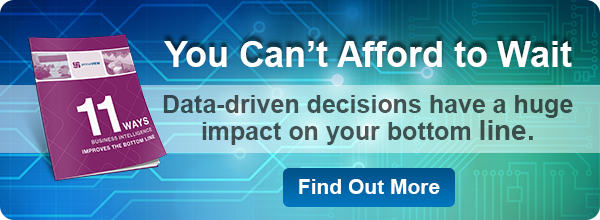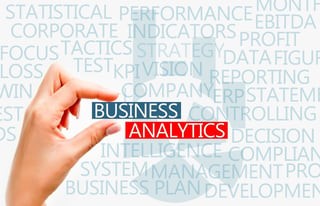 Likely you’ve heard the old Biblical reference about the fruitless outcome of trying to put new wine in an old bottle. Sometimes you just have to discard the old bottle and start afresh with a new one. From an organizational standpoint, that means scrapping the old ways and introducing the new. Business Intelligence with its Key Performance Indicators and dashboard views are the new wine of data-driven decisions. But as intoxicating as that may sound, if you try to introduce it into the old bottle of your organization’s old ways of reporting and communications, you may have an informational hangover. So what can the new bottle look like? I suggest the following may help, based on some of our BI customers’ successful practices:
Likely you’ve heard the old Biblical reference about the fruitless outcome of trying to put new wine in an old bottle. Sometimes you just have to discard the old bottle and start afresh with a new one. From an organizational standpoint, that means scrapping the old ways and introducing the new. Business Intelligence with its Key Performance Indicators and dashboard views are the new wine of data-driven decisions. But as intoxicating as that may sound, if you try to introduce it into the old bottle of your organization’s old ways of reporting and communications, you may have an informational hangover. So what can the new bottle look like? I suggest the following may help, based on some of our BI customers’ successful practices:
- Make BI part of your organizational culture - your mission and objectives
- Tie BI to performance incentives
- Use BI daily – communications and support
- Include BI in your monthly financial and operational performance reviews
Make BI part of your organizational culture – your mission and objectives
In our recent blog, I introduced the following:
“I like the concept of each organization focusing its decision making on its mission and objectives. BI helps significantly to do just that, because executives and management can identify and align Key Performance Indicators (KPIs) to the broader organization’s mission, goals, strategies, and culture as well as to each of its business units’ objectives. The magic of BI is that the information displayed can be rolled up or drilled down to specific levels of interest and responsibility within the organization. Let’s say that the COO, who likely would never log into his or her organization’s clinical application, can view a consolidated corporate view or an expanded view of all regions’ or facilities’ clinical KPIs. Likewise, a department head can view his or her specific KPIs benchmarked against department-specific goals.”
Doing so, makes the next step easier.
Tie BI to performance incentives
One of our customers, operating over 40 buildings across five states, has tied administrator and other executive incentive plans to the KPIs specific to their responsibilities. Doing so keeps the entire organization focused on tightly-defined outcomes tied to the company’s overall mission and objectives as mentioned above. This makes accountability measurable and immediate. And because BI is “real time”, it is a useful tool for coaching, facilitating, supporting, and redirecting. This unique level of transparency is motivational. It helps leaders to review their performance trends and, where appropriate, even within the context of how they are doing compared to their peers.
Use BI daily – communication and support
Many of our customers use BI in their daily morning stand-up meetings. Because of the dashboard’s flexibility, the dashboard administrator can determine who sees what information based on predetermined roll-based permissions. Department heads can view their relevant KPIs, while their administrators/executive directors can view all department and facility-specific KPIs. Regional managers and consultants view consolidated regional information as well as specific facility and department performance. CEOs, COOs, and CFOs can view consolidated information at a corporate level or drill down to region and facility information as desired.
This helps also to simplify communication up and down the organizational structure. Facility, regional and corporate staff no longer have to ask, “What?” They can dwell on the “why” and what to do about the opportunities or challenges that the “what” reveals.
Include BI in your monthly financial and operational performance reviews
One COO of a multi-facility chain, reports that he uses the dashboard during the monthly financial and operational reviews. “Today with primeVIEW (PCT’s BI dashboard) conspicuously displayed on a large monitor in his office for group discussion, (Ray Tyler, COO of Health Services Management Group) and (his) team can observe and examine such Key Performance Indicators (KPIs) as census, labor, RUG levels, and accounts receivable throughout the day. His use of primeVIEW goes beyond daily operations; Tyler also refers to it during his monthly financial reviews with facility administrators who simultaneously view performance in areas of focus. ‘By the time our P&Ls are ready, they are a month or more in arrears,’ commented Tyler. ‘But with primeVIEW, we can discuss what happened last month and examine current KPIs which directly impact financial performance and help us predict month-end outcomes.’”
Summary
Business Intelligence can become an integral part of your organization’s communication, management, leadership, and accountability structure. Inculcating in how you lead and oversee your business can yield significant dividends.
/Prime-Care-Technologies-Logo.png?width=191&height=55&name=Prime-Care-Technologies-Logo.png)


 “business intelligence” (or business analytics) and convert it to “intelligent business.” Sometimes, playing with words (which is fun for me at times) can reshape our paradigms. “Business intelligence” implies the use of systems and processes which simplify the retrieval of data and its conversion into actionable information readily accessible to decision makers in real time
“business intelligence” (or business analytics) and convert it to “intelligent business.” Sometimes, playing with words (which is fun for me at times) can reshape our paradigms. “Business intelligence” implies the use of systems and processes which simplify the retrieval of data and its conversion into actionable information readily accessible to decision makers in real time DULUTH, GA, May 4, 2015 – Prime Care Technologies, Inc., the nation’s leader in technology-powered business solutions for providers of long-term/post-acute care (LTPAC), today announced the launch of a comprehensive solutions platform.
DULUTH, GA, May 4, 2015 – Prime Care Technologies, Inc., the nation’s leader in technology-powered business solutions for providers of long-term/post-acute care (LTPAC), today announced the launch of a comprehensive solutions platform. Likely you read the article in the November 14, 2014 McKnight’s Daily Update entitled,
Likely you read the article in the November 14, 2014 McKnight’s Daily Update entitled,  So what’s a provider to do? Assuming providers have integrity, let’s discuss accuracy. In the past, when I was running buildings, I had to collect the data and create the reports manually, cross-checking multiple times to make sure the reports were accurate - a laborious, tedious, and time-consuming task. Providers today, however, have a much easier and time-saving alternative - automated data mining and business intelligence (BI). Retrieving, compiling, and repurposing the data into useful, relevant, timely, accurate, and actionable information is fully automated through data mining and BI technologies. The data comes directly from the provider’s time and attendance and payroll systems, combined with its clinical and financial software. The BI tool retrieves that data and stores it in a data warehouse from which it creates reports usually viewable in a dashboard. Further, the reports can be as “real time” as the provider needs them to be. As soon as an employee punches in or out that data is stored and therefore information can be retrieved and reported throughout the day.
So what’s a provider to do? Assuming providers have integrity, let’s discuss accuracy. In the past, when I was running buildings, I had to collect the data and create the reports manually, cross-checking multiple times to make sure the reports were accurate - a laborious, tedious, and time-consuming task. Providers today, however, have a much easier and time-saving alternative - automated data mining and business intelligence (BI). Retrieving, compiling, and repurposing the data into useful, relevant, timely, accurate, and actionable information is fully automated through data mining and BI technologies. The data comes directly from the provider’s time and attendance and payroll systems, combined with its clinical and financial software. The BI tool retrieves that data and stores it in a data warehouse from which it creates reports usually viewable in a dashboard. Further, the reports can be as “real time” as the provider needs them to be. As soon as an employee punches in or out that data is stored and therefore information can be retrieved and reported throughout the day. Data mining represents wealth, a wealth of opportunity, action, and success. Directly put, data mining (the process of centralized data management and retrieval) helps LTC providers find hidden treasures of knowledge, not just data. Just as rare gems or precious minerals are only valuable when processed from the ore that is unearthed, so too is knowledge when refined from countless bytes of data. Refined data transformed into information becomes knowledge and knowledge – the power to act. Data mining, therefore, helps executives discover what is happening now, track trends, anticipate with some accuracy what may happen in the future, and explore the strengths of possible actions.
Data mining represents wealth, a wealth of opportunity, action, and success. Directly put, data mining (the process of centralized data management and retrieval) helps LTC providers find hidden treasures of knowledge, not just data. Just as rare gems or precious minerals are only valuable when processed from the ore that is unearthed, so too is knowledge when refined from countless bytes of data. Refined data transformed into information becomes knowledge and knowledge – the power to act. Data mining, therefore, helps executives discover what is happening now, track trends, anticipate with some accuracy what may happen in the future, and explore the strengths of possible actions.